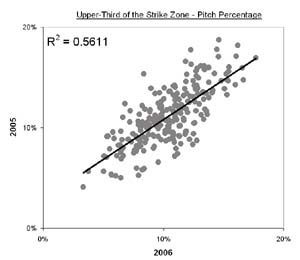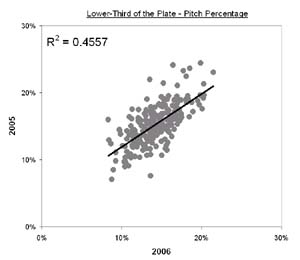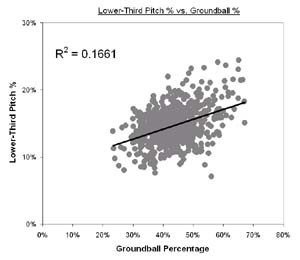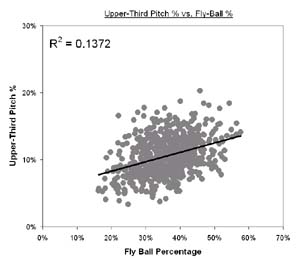
| Designated Hitter | November 02, 2006 |
How often have you heard a player attribute his success to "throwing more pitches inside," or heard a manager say a pitcher was "hitting his spots?" Pretty much everyone talks about pitch location, but how often is it actually quantified? Thankfully, our pals over at Baseball Info Solutions tracked the x-y coordinates of nearly all 1.5 million pitches thrown the past two seasons. Let's start by looking at the average major league pitch locations broken down by batter/pitcher handedness.

Excluding pitches outside the strike zone, about 14% of the pitches are thrown to the inside third of the plate, while about 25% of the pitches are thrown to the outside third of the plate. If you include the pitches outside the strike zone, 30% are thrown "inside" while over 50% are thrown "outside."
Then of course you can break down the strike zone by upper and lower thirds. Once again, excluding pitches from outside the strike zone, 10% are thrown to the upper-third, while 15% are thrown to the lower-third. Including the pitches outside the strike zone, 24% are thrown to the "high" and 40% are thrown "low."
While the league averages are good to know, each player will have his own pitching style. Let's see if we can learn anything about how a pitcher performs by where he throws the ball. Let's take a look at three things for each pair of pitch locations.
- Do pitchers tend to throw the ball to the same location year after year?
- Which pitchers throw the ball to a particular location the most?
- What does throwing to that location generally mean for pitchers?
For the purpose of this study, the strike zone coordinates has been mirrored for left-handed batters in order to lump inner or outer pitches into a single metric.
The Inner and Outer Pitch
First of all, the ability or choice to throw strikes on the inner or outer third of the plate is something that an individual pitcher will tend to repeat from year to year.


So who are the starting pitchers that use the inside-third or outside-third of the plate the most?
Starter Inside-% Starter Outside-% Randy Johnson 21.69% Greg Maddux 32.11% Jon Lester 20.59% Mike Mussina 31.18% Matt Clement 20.49% Rodrigo Lopez 31.05% Johan Santana 19.46% Eric Milton 30.61% Francisco Liriano 18.77% Kyle Lohse 30.43% Andy Pettitte 18.73% Brad Radke 30.43% Cliff Lee 18.60% Kevin Millwood 30.24% Tim Wakefield 18.17% Roger Clemens 29.79% Mark Buehrle 18.12% Livan Hernandez 29.71% C.C. Sabathia 18.02% Brett Myers 29.55%
It's a pretty interesting group of starters who have the highest percentage of pitches over inner-third of the plate. Most of them are left-handers with Clement and Wakefield being the exceptions. Obviously Johan Santana and Francisco Liriano are considered two of the best pitchers in baseball and interestingly Chris Carpenter, a right-hander, was one shy of making the top ten.
The starters with the highest outside pitch percentage are all right-handers with Eric Milton being the lone exception. Jeff Francis and David Wells are also a few of the left-handers who really utilize the outer-third of the plate.
Let's move on to the relievers:
Reliever Inside-% Reliever Outside-% Mariano Rivera 30.07% Scott Cassidy 34.43% Chad Bradford 24.34% Brian Sweeney 33.00% Billy Wagner 23.20% Bob Howry 32.32% Todd Jones 23.20% Justin Speier 31.89% Matt Thornton 22.58% Brandon Lyon 31.64% Darren Oliver 22.00% Joe Beimel 31.64% Brad Thompson 19.95% Brian Meadows 31.63% Mike Gonzalez 19.83% Chris Britton 31.58% Hong Chih Kuo 19.21% Rafael Betancourt 31.40% Matt Capps 18.44% Takashi Saito 31.33%
There's definitely more of a mix of right-handed and left-handed pitchers from the inner-third list of relievers, most notably Mariano Rivera who uses that portion of the plate more than any other pitcher in baseball. Jonathan Papelbon was also a few spots shy of making the list.
The top 10 relievers who utilize the outer-third of the plate are all right-handed pitchers with the exception of Joe Beimel. Most of these pitchers had solid years, with Cassidy and Saito being the real bright spots.
Unfortunately, how a pitcher utilizes the inside or outside third of the plate doesn't really correlate well with anything. This was somewhat of a surprise to me, especially since the horizontal location of pitches is frequently addressed by many pitchers and scouts.
The Upper and Lower Pitch
Just like the inner and outer pitch locations, the percentage of pitches thrown to the upper/lower third of the strike zone also correlate well from year to year.


Let's see which starting pitchers utilize these sections of the strike zone the most:
Starter Upper-% Starter Lower-% Scott Baker 18.42% Brandon Webb 21.47% Matt Cain 16.03% Jake Westbrook 20.34% Chris Young 15.47% Mark Mulder 20.26% Brad Penny 15.44% Mike Maroth 20.22% Rich Hill 15.41% John Thomson 19.84% Johan Santana 15.39% Josh Fogg 19.72% Jarrod Washburn 15.29% Zach Duke 19.55% Ben Sheets 15.22% Jamie Moyer 18.76% Kevin Millwood 14.59% Roy Halladay 18.53% Boof Bonser 14.18% James Shields 18.50%
The starters who throw to the upper-third of the strike zone are mostly fly-ball pitchers, with a few exceptions like Millwood and Penny. While the players who throw to the lower-third of the strike zone are mostly groundball pitchers. In fact, Webb, Halladay and Mulder are three of the most extreme groundball pitchers around, not to mention Derek Lowe, another extreme groundball pitcher, just missed the cut.
Here are the relievers:
Reliever Top-% Reliever Lower-% Jonathan Papelbon 20.29% Chad Bradford 20.20% Rafael Soriano 18.42% Todd Williams 19.87% Rafael Betancourt 17.68% Rick Bauer 19.35% Alan Embree 16.65% Joe Beimel 19.11% Todd Jones 16.55% Jorge Julio 18.94% Joaquin Benoit 16.19% Salomon Torres 18.48% J.J. Putz 16.07% B.J. Ryan 18.33% Mike Timlin 15.98% Scott Downs 17.74% Mike Gonzalez 15.78% Josh Hancock 17.67% Julio Mateo 15.29% Chad Paronto 17.43%
The relievers who throw to the upper third of the strike zone the most make up a fairly impressive list of pitchers; most notably Papelbon, Putz, and Soriano with the others being not too shabby. The relievers who utilize the lower-third of the strike zone are for the most part, groundball pitchers except for the best of them, B.J. Ryan.


Unlike the lack of correlation the inside/outside third of the plate showed with any mainstream stats, the upper/lower third of the strike zone showed some correlation with groundball and fly-ball percentages.
The Center of the Plate
Last but not least is the middle of the plate, a spot where pitchers should not be throwing the ball all that often. Batters easily do the most damage with pitches right over the heart of the plate.
Unlike the inside/outside/upper/lower thirds of strike zone, pitchers do not throw the ball to this location with the same consistency from year to year. Instead of listing which player threw it over the center of the plate most often and least often; I'll cut right to the chase.
Since throwing the ball in the center of the strike zone, on an aggregate level, is where batters do the most damage, I thought there might be a decent correlation with either batting average on balls in play (BABIP) or perhaps home runs. This is not the case.
There are plenty of players who throw the ball over the center of the plate more frequently than others and quite simply get away with it for reasons that can't be put under a general rule of thumb.
Conclusions
Besides the correlation that the upper/lower thirds of the plate had with groundball and fly-ball percentage, there's really not a lot of assumptions you can make about a player by where he pitches the ball on aggregate.
It's interesting to know that Mariano Rivera throws the most pitches over the inside-third of the plate, or that Brandon Webb throws the most balls in the lower-third of the strike zone, but that by itself is really just trivia.
There's a lot to be learned from pitch location and it's going to take some complex modeling to fully interpret it along with pitch-type and velocity. But as far as generalities go with pitch location? There pretty much aren't any.
David Appelman is the creator of FanGraphs.com. You can contact him via e-mail.
Comments
Really interesting stuff. I haven't seen anything on this before.
Posted by: leno40 at November 2, 2006 1:14 AM
Batters easily do the most damage with pitches right over the heart of the plate.
You state this is true and intuitively we believe it, but is this supported by a study of this data somewhere else? How does the heart of the plate compare to the other locations? It seems to me there is a lot of information to be mined from the results for different locations and different pitchers. Especially if a pitchers locations changed from one year to the next.
Posted by: TT at November 2, 2006 5:42 AM
This is great stuff and it opens the door to some even more in-depth and insightful analysis. I'd love to see the breakdown of pitch location by the count (i.e. 2-0 pitch vs. 0-2).
Posted by: Redders at November 2, 2006 6:21 AM
You state this is true and intuitively we believe it, but is this supported by a study of this data somewhere else?
I charted where batters do the most damage in this study before the 2005 season: Palatable PitchZones It's probably worth charting these again with 2006 data included.
I didn't list the pitchers who threw down the center of the plate the most/least, but some names of note who threw it down the center the most are: Paul Byrd, Roy Oswalt, C.C. Sabathia, Kip Wells, Ben Sheets, Anibel Sanchez.
There's a pretty good mix of pitchers here and I can guess at why some are successful throwing the ball down the center and others not.
On the throwing the ball down the center the least you have, Matt Clement, Horacio Ramirez, David Wells, Tom Glavine, Barry Zito, Schilling, Moyer, Clemens, Josh Beckett.
I'm not too surprised too see a few of these names, but considering how many home runs Beckett gave up, seeing him here is surprising, along with Clement and Ramirez. I guess Clement and Ramirez didn't pitch a whole lot this season though.
I also looked at fastball velocity to see if that had any sort of correlation with how often a pitcher throws the ball down the center, and it didn't.
Either way... it really depends on who's throwing the ball down the center of the plate and not just if they are.
I used to look at this type of data doing the Daily Graphing series like with Tom Glavine or Curt Schilling to try an explain statistically, why players perform like they do. After doing this particular pitch location study, even if I find something that I think sounds like it should be the reason for a pitcher's success or failure (like throwing the ball down the center of the plate less, or pitching inside), it's tough to really validate that is the actual cause because there's really no rule of thumb. It'd be more of an educated guess.
Posted by: dkappelman at November 2, 2006 6:55 AM
Excellent work, David. I'm surprised that more lefties didn't show up on the "outer half" list -- probably because when I think of lefties, I think of Tom Glavine, who used to live on the outside part of the plate.
Also, regarding lack of correlation between "inside/outside" and anything else: Could it be that the key isn't so much throwing a large percentage of pitches in one spot or another as it is being able to pitch to both areas effectively? When I hear people talk about horizontal location, it seems to me it's usually in that context, i.e., "this guy can work both sides of the plate."
Just my 2 cents. Good stuff...
Posted by: Geoff Young at November 2, 2006 7:09 AM
I would have to guess that pitch type plays a big role as well. Curve balls down would be more effective than curve balls that hang up in the zone. Sliders down and away are more effective than sliders inside.
Going with the aggregate numbers is, as the author puts it, good trivia, but if it were broken down into 5-6 categories by pitch, I suspect the data would be much more revealing.
Posted by: Aaron at November 2, 2006 7:26 AM
Very interesting analysis. Two thoughts:
1) it would be interesting to know if pitchers get hit more/less when they pitch in their preferred zone, and when they don't. So, for pitchers who predominantly go outside, what's the hit percentage on their outside pitches? And do they get hurt when they come inside? Or maybe they achieve the right balance so the hit % is about the same either way.
2) If pithing in middle of plate matters, you'd want to distinguish between cases when a pitcher wanted to do it and when he did it inadvertently. So, you could look at good hitters vs. bad at plate, and at hitter's counts vs. pitcher's counts. Still, the percentage of balls in that zone may be too small to show anything.
Posted by: Guy at November 2, 2006 7:38 AM
While pitch location is important, I think it is only part of a pitcher's equation. Pitchers do not get hitters out by throwing to spots alone. Control and change of speed have to factor in, otherwise correlations will be hard to come by.
So, in that respect, I think your examination was a success since generalities were non-existant.
Posted by: Megary at November 2, 2006 11:05 AM
very interesting. i applaud you.
Something you might want to consider is the speed of the pitch. Not all pitchers can afford to throw on the outside part of the plate because it allows the hitter more time to react to a pitch. It's not surprising that a strong arm like johnson appears at the top of the list for outside presence. If a fastball isn't your forte then the inside is where you have to live. it takes a lot longer for the bat to come around on a ball that's jamming them...
Another consideration is the type of pitches. Since the majority of batters are right-handed, it also makes sense why johnson lives outside most of the time. It's a setup for his juicy slider (also his outpitch) which crashes in on righties...
just something to consider....your thoughts?
br
Posted by: Brian at November 2, 2006 11:06 AM
At some point, I would like to include pitch velocity and pitch type in the equation since they're obviously both very important. They're probably worth a look at independently too.
Ideally, I think you'd want to look at pitch sequences (including location, velocity, and type) which is where you'd possibly be able to quantify things like setup pitches and out pitches.
There are really countless things to explore using data like this and they're all fairly time consuming. As Tangotiger said, "All we need is more researchers."
Posted by: dkappelman at November 2, 2006 11:28 AM
i'm a stat-head well versed in spss. grad student at indiana university. if you ever need some data analysis help, just let me know..
br
Posted by: brian at November 2, 2006 11:47 AM
One thing I thought was interesting was that there seemed to be a lot of Red Sox that were on the list of pitchers who threw inside (Lester, Clement, Wakefield, and I'm pretty sure Bradford used to be a Red Sock). Is that just coincidence, or is it something on which they concentrate?
Posted by: Zac at November 3, 2006 12:09 PM
I'm surprised Zach Duke wasn't in the top ten for outside.
Posted by: Pirate at November 3, 2006 10:19 PM
Jamie Moyer is listed as someone who stays in the lower half of the zone, yet he is a flyball pitcher. Very interesting stuff here.
Posted by: Tom G at November 4, 2006 7:18 AM
isn't Johnson tops on the list for inside pitching, not outside? Or am I misunderstanding? Anyway either pitching style seems to me like it could be about equally easily rationalized: he throws hard, so he takes advantage of his fastball by pitching inside. Or alternatively he throws hard enough that he doesn't "have to" pitch inside often the way soft-tossers do.
Posted by: John C at November 4, 2006 1:27 PM